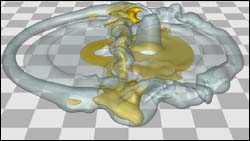Monthly News Summary – November 1997
In the News: November 1997
A record of SSEC media appearances compiled for November 1997. Direct comments, questions, and information about other SSEC references to Terri Gregory, SSEC’s Public Information Specialist.
Art and Computers
For More Information
It’s not unusual for professors and researchers from different disciplines to collaborate, but when the disciplines are as diverse as atmospheric science and art, it’s ground breaking. SSEC researcher and AOS professor John Anderson and art professor George Cramer, with colleagues in math, engineering, astronomy, biology, and computer science are uniting under the banner of computational science.
Art and computers can help us make sense of overwhelming data, helping us view things that are impossible to see. Tools like SSEC’s Vis5D and other readily available software can help scientists create animated pollution maps or images of dangerous storms called microbursts. John is excited about how artists can contribute by bringing an understanding of human perception into the visualization process.
Wisconsin Week, November 19, points to the current Science Coalition offering, Visualizing a New Community of Scholars, for an excellent description of John and George’s new program in computational science. The Science Coalition presents science news stories from universities and organizations around the U.S. The current offering is provided by the University of Wisconsin-Madison’s News and Public Affairs Office. Funding agencies include the National Science Foundation. An example of John’s collaboration is shown in the College of Engineering’s current Annual Report, Engineering Ideas for Tomorrow.
Field Trip to the Lake
For More Information
- Lake-ICE Lidar Operationsr
- Tripoli Nonhydrostatic Model
- Lake-ICE Links
- Lake-ICE Abstract
- Sheboygan Press
Lake Michigan is one big laboratory for scientists seeking small, fleeting parcels of air. In the Lake-Induced Convection Experiment (Lake ICE), scientists will study small-scale convection, vertically-moving air parcels that are little understood but have big implications for local weather and our ability to study and forecast it. In December and January with funding from the National Science Foundation, researchers from the University of Wisconsin-Madison, the University of Michigan and other midwestern universities, and the National Center for Atmospheric Research bring their expertise, instruments, and airplanes to see how these hard-to-forecast atmospheric features evolve.
Lake Michigan offers a predictable, stationary, and warm surface for studying the vertical circulation of air. Ed Eloranta will take the Volume Imaging Lidar to a site in Sheboygan to attempt to image convection. Ed is eager to see how his instrument, which uses a pulsed laser beam, will display the three-dimensional structure of the atmosphere over time. Greg Tripoli (AOS professor) and Brad Hoggatt (SSEC) will test Greg’s regional forecast model in the experiment, a particularly difficult one to model because convection features are so small and spring up so suddenly. Brad and Greg hope to use GOES soundings in their model, provided by CIMSS. Watch The Sheboygan Press for coverage of Lake-ICE and catch next month’s In the News for more coverage.
SSEC in Print
For More Information
Islands magazine used before and after sea surface temperature images from SSEC’s Web site to illustrate El Niño Alert. Islands is most concerned with ill effects on coral reefs and islands around the world, including the Galapagos where pupping rates of seals fell by 90% during the 1982-83 El Niño season. With temperatures 14 degrees above normal, the right sort of food was unavailable for mother seals.
Colorado’s Insite monthly magazine will also use SSEC satellite images in a story focusing on El Niño. They conclude that nobody really knows how El Niño will affect Colorado and are hoping for snow anyway.
Mark Ward, Milwaukee Journal Sentinel, used background from planetary scientist Sanjay Limaye in his column on Cassini (October 20). Mark summarizes what scientists know now about Saturn and why the Cassini probe is so important. Mark’s science column runs every Monday and deals with current scientific issues of interest to the general public.
SSEC on the ‘Net
For More Information
The Mednets Web site uses SSEC’s global montage on its Weather page. Click on Weather in the upper right corner. This unusual site is run by cardiologist Peter Gregor who links to an amazing array of information besides the expected medical information. It’s a perfect site for a busy professional who wants to stay well-rounded.
Another amazing “list of lists” is Jim Ehleringer’s. Jim is a biology professor at the University of Utah. He lists the SSEC home page under Weather Sites/Satellite Images.
Teaching and Outreach
For More Information
Graduate School Dean Virginia Hinshaw referred to two SSEC projects in her November Roundtable talk to university staff and faculty. As examples of cutting edge research in the physical sciences, she used SSEC’s projects, Vis5D and the Galileo Probe Net Flux Radiometer. SSEC is a research center within the Graduate School, which Dean Hinshaw directs.
